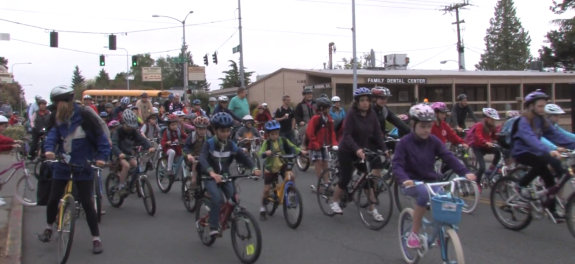
Organizing a bike train to school is an effective way to significantly increase the amount of daily physical activity every child needs to be healthy, a study out of Seattle Children’s found.
OK, I know that sounds like a no-brainer. And it is. But it’s cool to see that actual figures. The bike train activity alone accounted for 35 percent of participant kids’ daily recommended physical activity. That’s a big head start on the day, and could be one tool to help fight childhood obesity and other health issues related directly to inactivity.
The study group was “fourth–fifth graders from four public schools serving low-income families in Seattle,” according to the paper’s abstract. Bike Works helped by providing bikes and safety education to the kids, and study staff led the trains. The bike trains were in 2014, with analysis in 2015 and 2016. Academic research just takes a long time to get out.
The study was published in the the American Journal of Preventative Medicine. I’ll let the Seattle Children’s press release take it from here:
Children who participated in adult-supervised group bicycle rides to and from school increased their moderate-to-vigorous physical activity by 21 minutes per day and daily cycling commutes by 45%, according to a pilot study recently published in the American Journal of Preventive Medicine.
The additional exercise study participants gained from riding in the groups, known as bike trains, accounted for 35% of the 60 minutes of physical activity recommended daily for children.
“Regular physical activity can help build muscle and bone strength, raise energy levels, and help reduce the risk of conditions like obesity and heart disease,” said Seattle Children’s researcher Dr. Jason Mendoza, who served as the principal investigator for the study.
Mendoza has also led and collaborated on research studying walking school buses, where adults supervise groups of children as they walk to and from school.
“Several studies have looked at the health benefits of walking to and from school. This is the first study that examines a bike train program,” Mendoza said.
The study specifically looks at the impact of organizing a bike train at a neighborhood school and helping interested students get access to a bike so they can participate. That’s a very replicable model. If your kids’ school doesn’t have any bike trains yet, maybe it’s time to find some other interested parents and start one.
Here are some resources Seattle Children’s suggests:
There are several resources for those who wish to start a bike train in their community. The SRTS bike train planning guide focuses on planning a route and ride schedule; safely equipping and preparing riders and leaders; and extensive safety checklists applicable to bike riders of all ages.
The Pedestrian and Bicycle Information Center provides links to cycling resources in every state, including state-specific cycling laws, cycling plans, and contact information for state bicycle and pedestrian coordinators.
“Engaging daily in a fun, safe activity such as biking, is an important way we can increase physical activity to ensure optimal child development and health,” Mendoza said. “There is a long way to go, but we will continue to research and help children, families and schools, especially those who are socioeconomically disadvantaged, to tap into and re-discover ways to live the healthiest life possible.”







